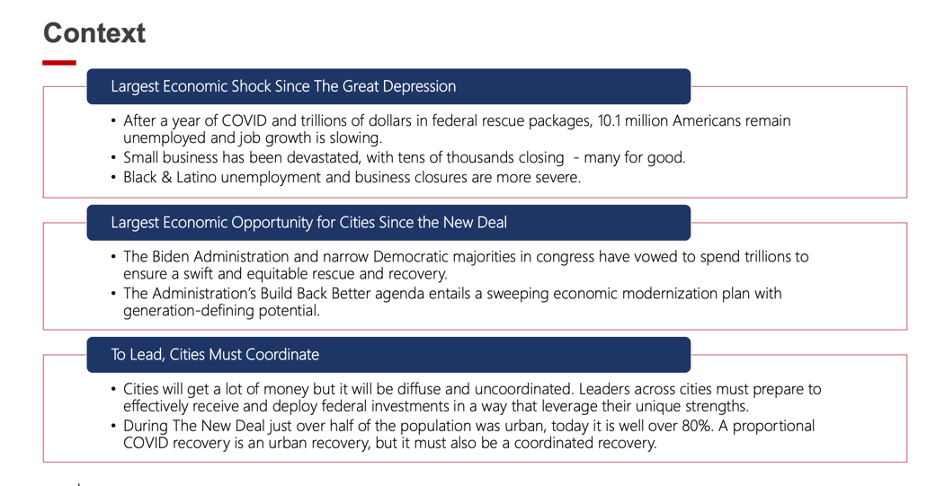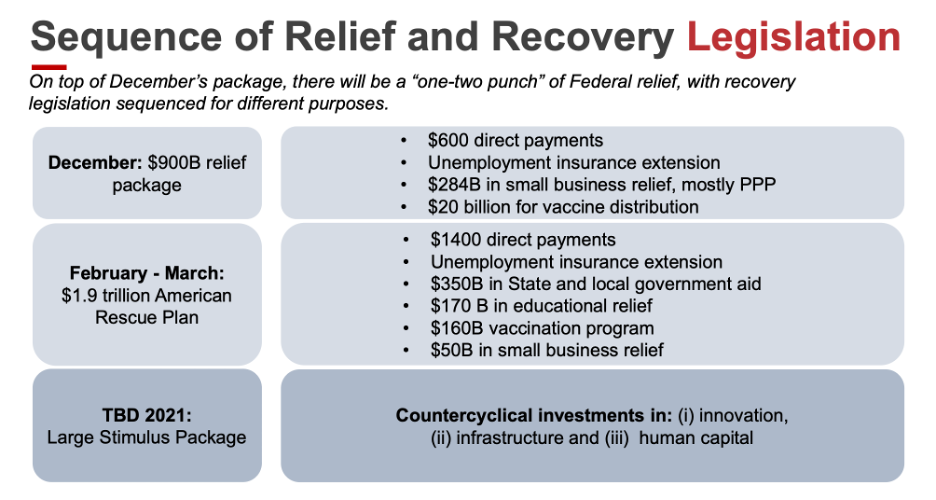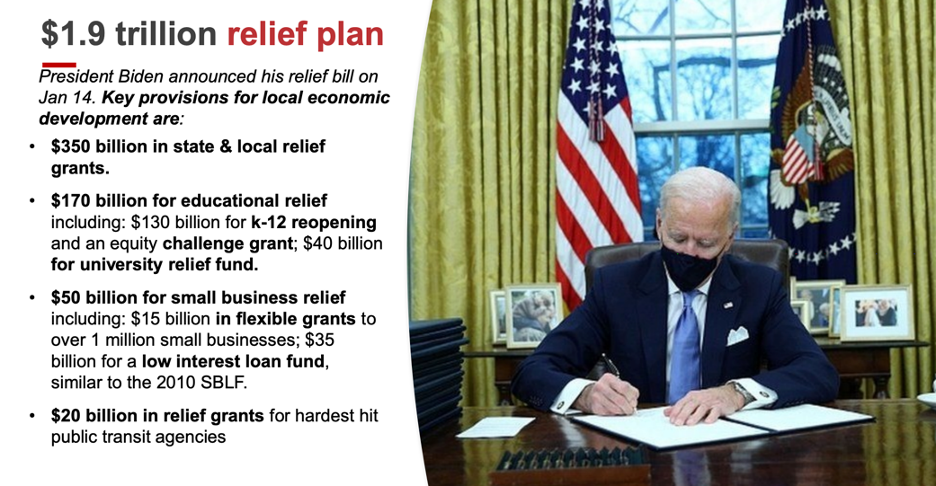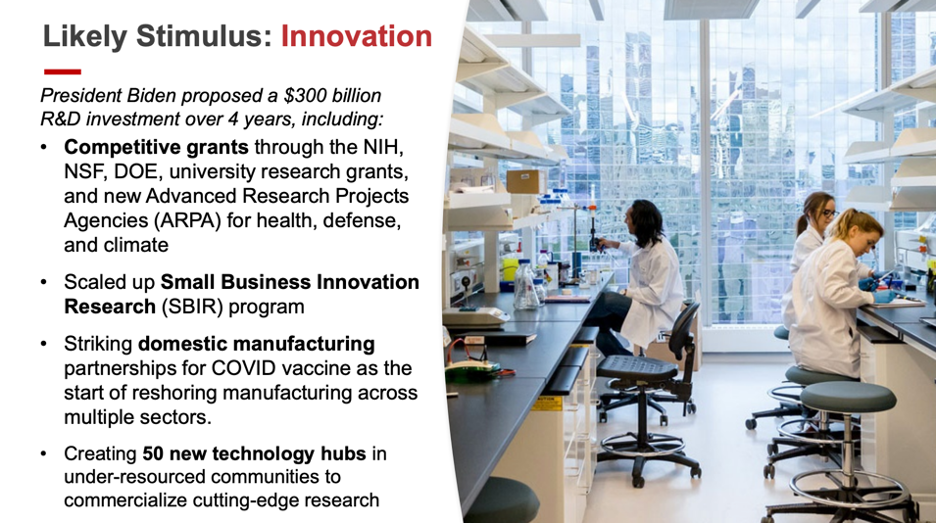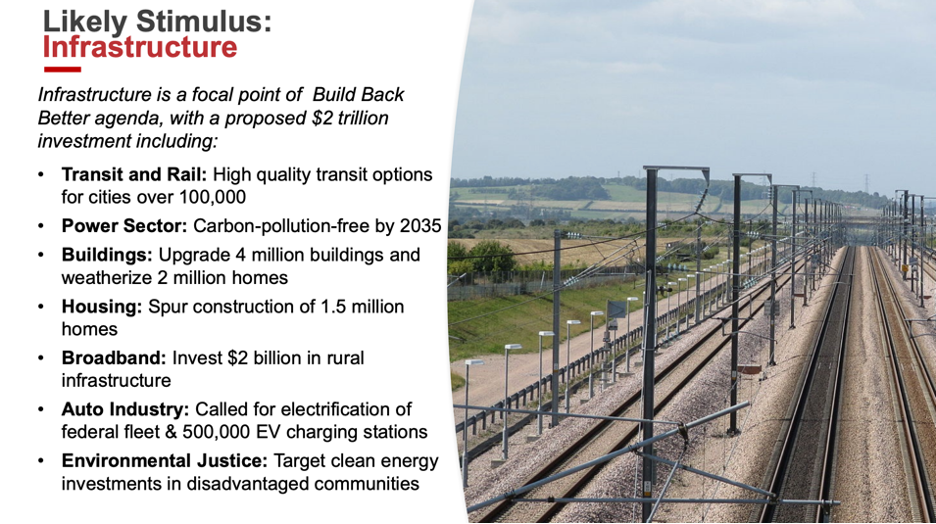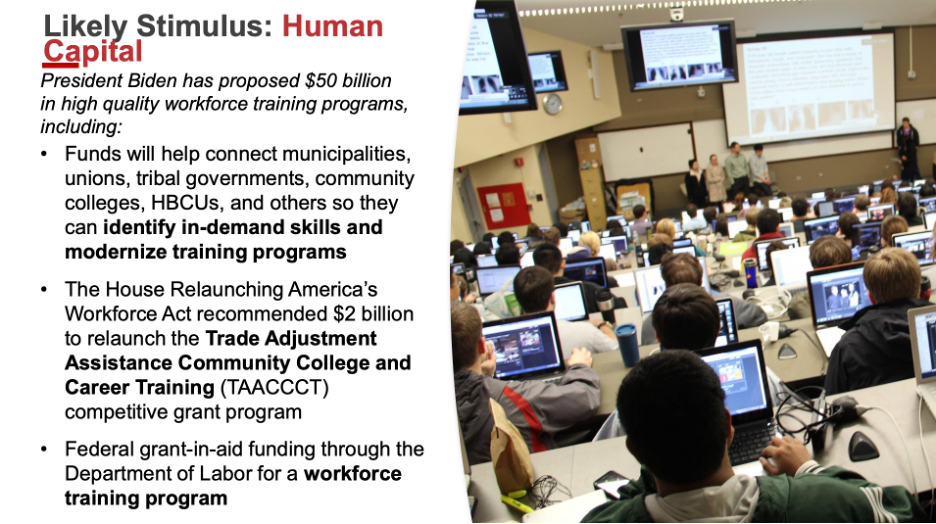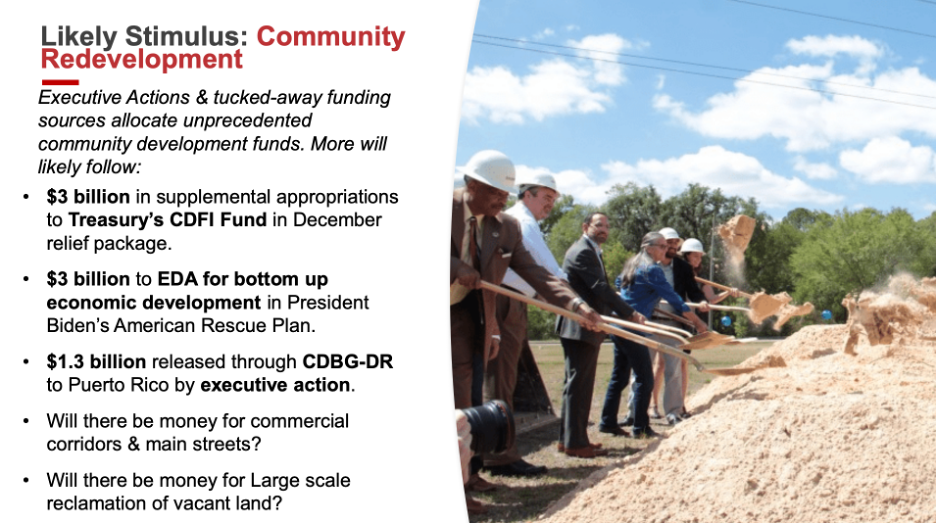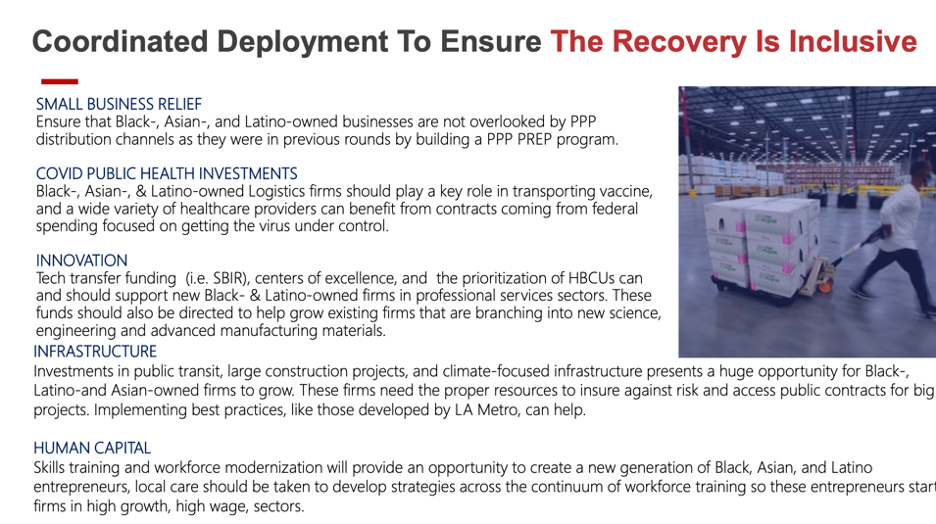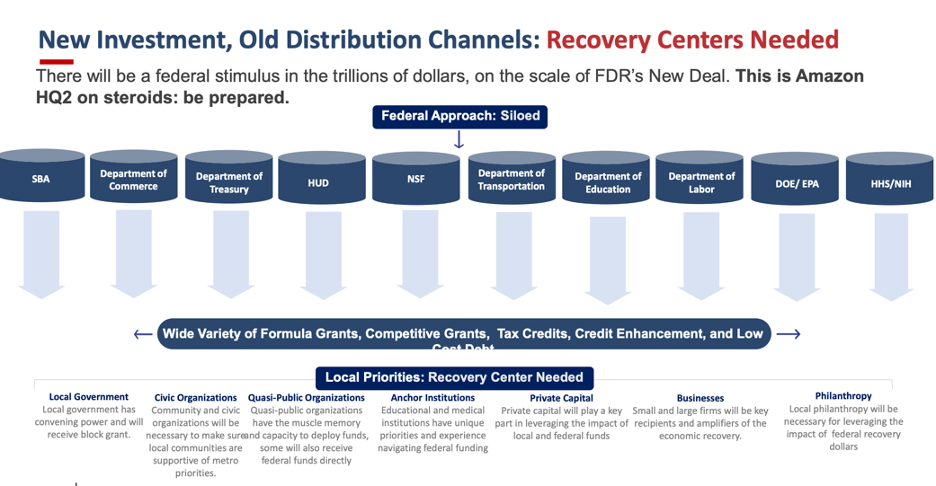The events of the past year laid bare the inequities of both the national and local economies. The about-to-be-signed $1.9 trillion American Rescue Plan Act seeks to provide individuals, cities, states, businesses, schools, and transit agencies with the funding and financial tools to implement a robust, green, and equitable economic recovery. TPR excerpts here, Bruce Katz, Founding Director of the Nowak Metro Finance Lab at Drexel University in Philadelphia, at the Los Angeles Economic Development Corporation’s debut of their 2021 Economic Forecast. Katz offers insights on how cities across the country are preparing for this unprecedented federal investment and strategizing to ensure an equitable and resilient recovery.
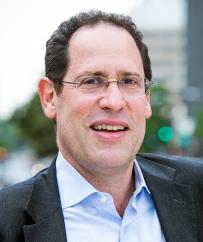
“If we've learned anything since this virus has started, it’s the federal government can send resources out, hopefully provide guidance based on science, but cities and counties and states are the places that actually have to execute and deliver and implement them.”—Bruce Katz
Bruce Katz: I'm going today to really try to talk about how you can move from a concept to action in this next year of relief and recovery. Anyone can go through the data to a much greater extent than I will, but obviously we're experiencing the largest economic shock since the Great Depression. Our focus at Nowak Metro Finance Lab at Drexel University has been on this devastating impact on Black- and Latino-owned businesses and the decimation of many commercial corridors and main streets within which they are located.
But this provides an opportunity—because of the Biden administration and the change in Congress—for cities. It’s the largest opportunity with federal investment, really, since the New Deal. Just think about Amazon HQ2 on steroids, and you get a sense of what's coming down the pike here. What that requires is for cities to think very intentionally and purposefully—cities, counties, businesses, philanthropy, universities, nonprofits —about how you align and prioritize federal investments in ways that really fit your economy.
So, the election—particularly the Georgia Senate races that cemented Democrat control of the US Senate—has really completely changed the game. We now have leaders in the House, leaders in the Senate, and in the Biden-Harris Administration who understand cities and urban counties—leaders who understand the panoply of challenges that present in these places and have governed, like Mayor Pete or Mayor Walz or Governor Raimondo or Governor Granholm, in ways that really knit together infrastructure with innovation, workforce development with small business. So, this is a government, both in the House and the Senate and in the administration, led by people who understand urban places and the fact we are a metropolitan nation.
This is obviously a dramatic sea change.
What's coming is going to be stages of relief and recovery. We already have the December package; the $900 billion enacted at the end of December, which was principally focused toward unemployment, direct checks to families of individuals, and more small business relief from the Paycheck Protection Program.
But now we're cycling into the larger packages. First is President Biden's $1.9 trillion American Rescue Plan, which will provide more relief for state and local governments, accelerated vaccination program, school reopening support, less support for small businesses because that was in the December package. And after that, as we begin to move through this year, more typical counter-cyclical investments in innovation, infrastructure, and human capital.
So, the bottom line—the major message—is get ready because the funding is coming.
The American Rescue Plan with President Biden is again focused on more challenges that were not addressed at the end of last year. Remember there was a call for $2,000 checks? They ended up being $600, so they'll make up the difference. But there also wasn't relief for state and local governments, and what we've learned in the past since the Great Recession, is that if we do not provide support for state and local governments, the recession will be prolonged. So that's critical. School funding is critical as is funding for transit. And again, watch the state and local relief because it's very flexible. It will go directly to cities and counties and states, and it could open up more investment possibilities locally.
But then we get to the stimulus package. And the stimulus package will make a series of investments, fairly typical counter-cyclical investments to build back better frankly. In the category of innovation will be investments through traditional research agencies like NIH or NSF or the Department of Defense or the Department of Energy, but it will also focus on manufacturing, which is critical in LA County because of the port and the airport; LA’s still a major manufacturing center in the United States. It will also focus on new technology hubs—what we would call innovation districts—that co-locate advanced research with mature companies, with startup and scale-ups, incubators, and accelerators. Innovation is a key point.
Infrastructure will be a major part of this package. It will not be traditional infrastructure of just roads, bridges, rail, and transit. We're talking about a greening of the American energy sector, major investments in broadband, substantial investments in school modernization and school transformation, and the transformation, frankly, of the auto industry towards electric vehicles. If you look at the New York Times today, there was a major article about what that will mean for battery innovation. So infrastructure across multiple asset classes, multiple dimensions.
It is so critical that we see major investments in human capital because technological innovation is sweeping across manufacturing, healthcare, and the services sector with artificial intelligence, machine learning, big data analysis, software engineering. I think we're going to see major investments in community colleges for the credential of workers to enter these next generation of sectors and technologies. So, there will be workforce development programs for sure but also community colleges because they work so closely with business and clusters.
And then finally, this is a piece that actually hasn't really been teased out yet. Traditionally, there have been major investments in community redevelopment. We saw some of that last year with investments in the CDFIs. Community Development Finance Institutions were so critical to make sure that Paycheck Protection Program got to Black and Brown owned businesses that tended to be underbanked, undercapitalized. So CDFIs got substantial funding. EDA, the Economic Development Administration, got about $1.5 billion last year, and they're probably going to get $3 billion in this American Rescue Plan. That could be critical for both innovation and for small businesses. But I think there's going to be more coming here around larger scale community redevelopment, urban land banks, homeownership. So, watch this space because it's being developed really as we speak.
So, the question really for cities as you begin to think about this is not about just receiving funding, but deploying funding in a way that maximizes inclusive outcomes. That partly, from a business perspective, means supplier diversity and procurement policy, so that you can match up the purchasing of goods and services with Black and Latino owned businesses, which is an absolutely critical new source of business demand.
Diverse hiring and upgrading the skills of Black, Latino, Asian and other workers is critical to make sure that these individuals have access, the skills, capacity, and the capabilities to enter into the labor market with ladders of opportunity, better paying jobs, better benefits.
And finally, community redevelopment itself, because many of the investments around infrastructure and innovation will be near areas of high poverty. So the key is how do you leverage that up to have the largest wealth building effect for residents living in these communities? It's not just about getting the funds, or even getting ready for the funds, it's about deploying funds in an effective way. How do cities and counties harness these large, unprecedented federal resources?
Because the national government tends to focus or operate through silos and stovepipes, the Department of Energy, the Department of Commerce, Housing and Urban Development, it's really these vertical compartmentalized bureaucracies. When they come to ground, these funds need to be braided and blended together so that they have a two-plus-two-equals-five effect and have the kind of inclusive and sustainable outcomes that we want.
That's the role of cities and counties—not just government, but government in close collaboration with the business sector, philanthropies, universities, community groups, and others. So what we're working on now are what we're calling (and this phrase will probably change), Stimulus Command Centers where you literally declare your priorities locally, and then begin to harness federal investments around those priorities. This is a bottom-up recovery when you think about how the United States is actually organized with cities and counties and metropolitan areas, really, the units of the domestic and global economy.
So, how do we think this will play out? In Philadelphia, what we're doing is anticipating that federal funds will flow through multiple kinds of infrastructure. We're literally interviewing every single public authority, for the most part, that controls decisions about these funds: the port, the airport, the Department of Transportation, the commuter rail, the transit system, the public utility in Philadelphia, so that we could understand what are the current priorities that exist. Most of these public authorities have boards that have been appointed by the mayor, the county executives, or in which elected officials actually sit together to make some allocation decisions.
So what are the current priorities? Are they aligned with market? Do they have the biggest inclusive outcome? Have people really thought through to the employment issues I talked about before? So, basically getting ready means to talk to decision makers, essentially, and influencers, who will be the places where money flows through. So that's what we're doing in Philly to get ready.
Ultimately, as we begin to see these Stimulus Command Centers be created, they will declare Metropolitan plans as priorities. In Philadelphia after about a month of these conversations, which become very clear across public, private and civic stakeholders, is school modernization, school transformation, 21st century learning environments or high schools and community colleges are co-located. That seems to be the one driving priority that really unifies everyone.
In Detroit, and some other cities I've been working with, interestingly enough, what they're focused on is land reclamation, large parcels, and environmental remediation to get prepared for next generation manufacturing. In Detroit, not surprising given what General Motors has said, electric vehicles are going to be where the auto sector ultimately moves or even charging stations.
So, each city and metropolitan area, particularly the large ones, have ubiquitous challenges but they have distinctive competitive advantages and assets. And the key here is to try to line up what makes your place special and what you're prioritizing to the funding that's coming, but also make sure it's coming in a form where you can maximize its deployment.
The only issue here is always in America someone's doing something, right? Someone's taking the lead. What I have found is a group of business organizations, in particular and not surprisingly, have begun to take the lead on areas of policy within their realm. So, in Cleveland and St. Louis and in Cincinnati you're seeing a lot of focus on that, but always in the service of growing Black and Latino owned small businesses. And then other cities like Louisville, like Dayton, like Birmingham, like Philadelphia, Mayors are trying to be the conveners so that they can pull everyone together and really try to push forward, almost like a city investment guide to guide both events, but also to guide local action.
So, my main message here is, as predictable as anything else in this crazy period, federal investments are coming. They will only be as effective as local implementation. If we've learned anything since this virus has started, it’s the federal government can send resources out, hopefully provide guidance based on science, but cities and counties and states are the places that actually have to execute and deliver and implement them. Federal programs and policies are really only as effective as local implementation. And so, my message today is create your version of a command center for this tremendous county, city and Metropolis in which you live, and really harness and leverage these federal investments for long-term transformative effect.
- Log in to post comments



